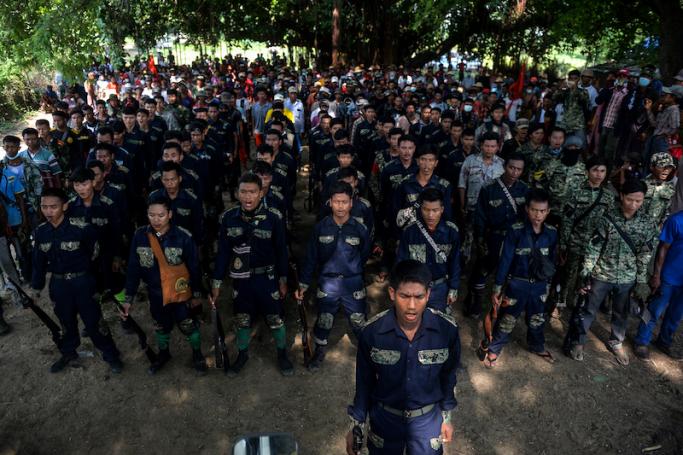For nearly three years, Anyar, also known as the "dry zone," has endured the ravages of conflict in Myanmar. The military junta's implementation of its "four-cuts" strategy, coupled with a scorched-earth policy and arbitrary arrests, has plunged this region into turmoil. This approach has resulted in the destruction of nearly a quarter-million homes, widespread arbitrary arrests, and a tragic loss of life.
Despite being the epicenter of Myanmar's Spring Resistance movement, Anyar remains unconquered by the regime. At the same time, the National Unity Government (NUG) faces challenges in mobilizing Local Defense Forces (LDFs) across the vast expanse of Anyar's regions.
The question now looms: Can Anyar's political development substantially influence the trajectory of the resistance movement?
The emergence of subnational groups in Anyar, such as the Sagaing Forum and the Anyar Region Strategic & Military Command, recently formed by LDFs and other resistant groups in Magwe, has raised concerns about their parallel structures potentially undermining the NUG's influence in the dry zone.
Reflecting on parallel systems, memories of my parents' shrine room in Anyar resurface. Though original Buddhism discouraged idol worship, they had both a Buddha statue and a Nat (deity or god-like spirit) figure displayed there. This duality vividly recalls the syncretic fusion of Nats with Buddhism during the 12th century AD, a concept that has endured for centuries in Burman households. Similarly, the Sagaing Forum and NUG share the common goal of overthrowing military dictatorship, despite employing different approaches.
The Sagaing Forum represents a fresh and bottom-up approach to addressing the challenges faced by the region, whereas NUG’s regional people defense forces, local administrators and tax collectors to manage township-level governance and battles.
So far, there is no direct collision between these two mechanisms. The Forum, through its people's humanitarian aid network comprising 27 local groups covering more than 30 townships, focuses on providing support for local communities suffering devastation from Myanmar military operations. Simultaneously, the Forum leaders have had a series of discussions with NUG’s Ministry of Defense to mobilize those Sagaing LDFs who are not under NUG’s regional command.
Sagaing political actors seem to be okay with these two regional structures, much like having two religious figures, Buddha and Nat, at home.
Though Buddhism emphasizes the middle path, my political experiences reveal that many adopt a "do or die" mentality, allowing only two possible outcomes: unequivocal success or utter failure. This approach, though intense, often lacks room for compromise. When I contemplated joining an armed resistance movement in the 1990s, my father tried to stop me from risking my life but expressed a similar sentiment, telling me, "I don’t want to see you until you can restore democracy to the country." His words echoed a desire for democracy, even if it meant prolonged separation and suffering. Sadly, I didn’t get to see him as he passed away before my family's reunion in 2015, following 25 years of exile.
Reflecting on this, I acknowledge that the "do or die" political approach of many groups in the field mirrors my father's convictions, embodying a rigid mindset that tolerates no middle ground. Remarkably, this unwavering mindset has sustained the armed resistance in the region, despite the junta's brutal campaigns employing indiscriminate violence against villages.
Yet, while this mindset spurs action, it can also hinder adaptability and compromise, disregarding nuanced realities on the ground. A poignant example lies in the inability of Bo Nagar, commander of the Myanmar Royal Dragon Army (MRDA), one of the strongest LDFs in Anyar and the NUG, to collaborate effectively. By signifying the "do or die" approach with religious duality, any of current leaders national and regional or local will struggle to unite groups in Anyar.
Leaders such as the late General Aung San and his daughter Daw Aung San Suu Kyi could only win the hearts of the people of Anyar. Amidst these dynamics, it's disconcerting that a lack of collaborative thinking among NUG-controlled groups and other local factions prevents effective defense not only of villagers but also of themselves in the future.
Reports from the ground suggest that Sr. General Min Aung Hlaing is launching major assaults to confront local Anyar PDFs, threatening to escalate the violence. The junta's increasing use of local village militias, Phyu Saw Htee, has intensified rivalry and polarization among supporting villages, leading to cycles of retributive attacks.
In the realm of politics, the local stakeholders' "do or die" mentality fuels their armed struggle against the regime, viewing this as a decisive moment that demands unwavering determination. It is important that anti-junta forces unite, regardless of organizational affiliations, focusing on shared objectives rather than leadership hierarchies.
Striking a balance between steadfast commitment and a pragmatic understanding of intricate political realities is vital for pro-democracy leaders and local actors alike.
In light of these complexities, it's worth considering whether those who effectively manage Anyar's groups - whether NUG or the military junta or any other regional group - will shape the trajectory of the resistance movement in the years ahead.












